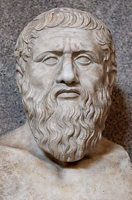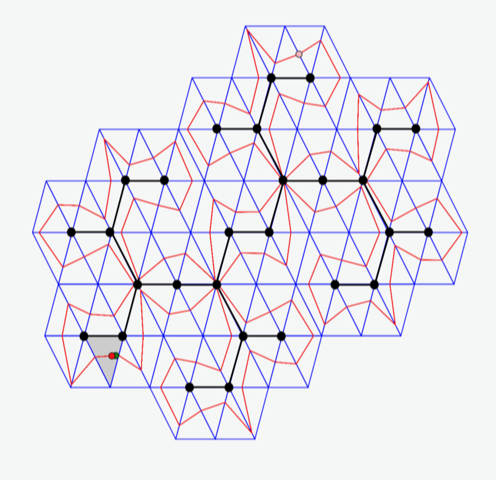Exposés
Résumés au format pdf : Résumés Miguel AcostaTitre: Ensembles limites et uniformisations au bord du plan hyperbolique complexe Le but de cet exposé est de donner quelques propriétés d'un ensemble limite d'un groupe particulier dans le bord du plan hyperbolique complexe. Le groupe en question permet d'uniformiser une variété hyperbolique réelle à pointe au bord du plan hyperbolique complexe. Après avoir défini les plans hyperboliques réel et complexe et l'ensemble limite d'un sous-groupe d'isométries, on regardera des uniformisations de variétés de dimension trois au bord du plan hyperbolique complexe. On décrira des uniformisations de fibrés unitaires tangents de surfaces ainsi que d'une variété hyperbolique particulière, tout en regardant l'ensemble limite des groupes correspondants. On décrira ensuite quelques propriétés de ce dernier ensemble limite, qui est particulièrement intéressant. Nguyen-Thi DangTitre: Mélange topologique du flot des chambres de Weyl Considérons le groupe de Lie simple $G= \mathrm{SL}(n,\mathbb{R})$, notons $A$ (resp. $M$) le sous-groupe des matrices diagonales de déterminant à coefficients positifs (resp. des signes) et $A^{++}$ le sous-ensemble ouvert des matrices de $A$ dont les coefficients sont ordonnés dans l'ordre strictement décroissant. Soit $\Gamma$ un sous-groupe discret de $G$, pas forcément un réseau. Je m'intéresse aux conditions de mélange topologique des actions $\Gamma \backslash G/M \curvearrowleft \phi^t$ où $\phi^t \subset A$ est un sous-groupe à un paramètre non-trivial. Dans le cas des réseaux, le théorème de Howe-Moore permet de conclure au mélange dans $\Gamma \backslash G/M$. Supposons donc que $\Gamma$ n'est pas un réseau. Lorsque $G= \mathrm{SL}(2,\mathbb{R})$, ces actions correspondent à l'action du flot géodésique sur le fibré unitaire tangent de $\Gamma \backslash \mathbb{H}^2$. En particulier, lorsque $\Gamma$ est Zariski dense dans $G$, celui-ci est topologiquement mélangeant sur son ensemble non-errant. Supposons maintenant $n\geq 3$. En 2000, J-P. Conze et Y. Guivarc'h ont construit un analogue $\Omega \subset \Gamma \backslash G/M$ de l'ensemble non-errant du flot géodésique et ont prouvé qu'il existait des $A$-orbites denses dans $\Omega$. Dans un travail commun avec O. Glorieux, nous obtenons une condition nécessaire et suffisante de mélange topologique pour les flots $\phi^t \subset A$ où $\phi^1 \in A^{++}$, dits de chambre de Weyl réguliers. Dans ma thèse, j'ai généralisé ce travail aux actions dans $\Gamma \backslash G$. Rhiannon DougallTitle: Measures on the boundary: an application to critical exponents of subgroups of groups acting on Gromov hyperbolic spaces, and amenability. This is joint work with R. Coulon, B. Schapira and S. Tapie. One of the first things we learn about a (proper) Gromov hyperbolic geodesic space $X$ is the construction of the visual boundary $\partial X$. An ergodic theorist then learns that for a discrete group of isometries $G$ acting properly on $X$, there is an interesting family of $s$-quasi-conformal measures on $\partial X$, called Patterson-Sullivan measures. And the smallest such $s$ coincides with the critical exponent $\delta_G$ of $G$: that is, $\delta_G$ is the exponential growth in $R$ of $Gx\cap B(x,R)\subset X$. For $G$ with "good dynamics", we expect that $\delta_G = \delta_H$ if and only if $H$ is co-amenable in $G$. We will review the history of results on this topic, and present our knew approach, for which we have an optimal conclusion, that if the action of $G$ is SPR, then we have $\delta_G = \delta_H$ if and only if $H$ is co-amenable in $G$. What is particularly appealing about our method is the construction of a new "twisted Patterson-Sullivan measure". Eduard DuryevTitle: Ribbon graphs, Masur-Veech volumes and intersection numbers on the moduli spaces A ribbon graph is a graph with a cyclic ordering of half-edges at each vertex. Given the ordering one can imagine thickening the edges of the graph and obtaining a surface with several boundaries. By assigning integer lengths to the edges we obtain a metric ribbon graph and the boundaries composed of edges also acquire lengths. How do we compute a number of metric ribbon graphs of given genus $g$ and fixed boundary lengths $b_1$,…,$b_n$? Kontsevich showed that such a number is a polynomial in $b_1$,…,$b_n$. Moreover, if we restrict to trivalent graphs, the coefficients of its top degree part are certain rational numbers, known as intersection of psi classes on the moduli spaces of algebraic curves. He also showed that these numbers obey a series of relations, a KdV hierarchy, which makes it easy to compute them explicitly. I will discuss what happens if we consider graphs with vertices of any valencies and how can this story be used to compute Masur-Veech volumes, or asymptotic number of square-tiled surfaces. This is a joint project with Elise Goujard. Anna FlorioTitre: Torsion des intersections homoclines transverses sur l'anneau Pour un difféomorphisme de l'anneau $f$ de classe $C^1$ isotope à l'identité, la torsion est la limite de la vitesse angulaire moyenne des images des vecteurs tangents sous l'action de la différentielle de $f$. Nous donnerons la définition de torsion ainsi que des exemples. En particulier, nous étudierons la torsion pour des fers à cheval obtenus à partir des intersections homoclines transverses de points périodiques hyperboliques. Title: Torsion for transverse homoclinic intersections on the annulus For a $C^1$ diffeomorphism $f$ on the annulus isotopic to the identity, the torsion is the limit of the average rotational velocity of the images of tangent vectors under the action of the differential of $f$. We will give the definition of torsion as well as some examples. In particular, we will study the torsion of horseshoes which arise from transverse homoclinic intersections of hyperbolic periodic points. Malo JézéquelTitle: Trace formulae and dynamical determinants for Anosov flows In order to study fine statistical properties of an Anosov flow, one may introduce the notion of Ruelle resonances. These resonances are complex numbers, with spectral theoretic interpretation, that are in principle hard to compute (except maybe in some very particular cases, such as geodesic flows on compact hyperbolic surfaces). However, these resonances are known to be the zeroes of a dynamical determinant (an entire function defined from the periodic data of the flow). We will discuss the validity of a morally stronger relationship between Ruelle resonances and periodic orbits (a trace formula conjectured by Dyatlov and Zworski), and explain how it is related to complex analytic properties of the dynamical determinant. Abdoul Karim SaneTitre: Graphe de chirurgie sur les cartes unicellulaires Certains objets topologiques (3-variété, noeud, triangulations d'un polygone...) ont des structures de graphes définies à partir de relations d'incidences. On sait par exemple qu'une 3-variété M quelconque, est obtenue par chirurgies de Dehn sur la 3-sphère. Cet exposé s'inscrit dans cet ordre d'idées. On parlera du graphe de chirurgie sur les cartes unicellulaires sur une surface fermée et de quelques une de ces propriétés géométriques. Davi ObataTitle: Stable ergodicity and other ergodic properties for a certain class of partially hyperbolic skew product In the last three decades, several works have been done about stable ergodicity. Due to a famous conjecture by Pugh and Shub, most works were done in the partially hyperbolic scenario. In this scenario one of the key properties used is something called accessibility (or essential accessibility). In this talk I will discuss some elements in the proof of stable ergodicity of an example of partially hyperbolic skew product introduced by Pierre Berger and Pablo Carrasco. It has two dimensional center bundle, with both exapanding and contracting directions along the center, it does not admit any further dominated splitting of the center, and it is non-uniformly hyperbolic. I also explain how the techniques developed also allow to obtain ergodic properties for non conservative perturbations of the example, in particular, the uniqueness of SRB measure, and uniqueness of measure of maximal entropy. Olga Paris-RomaskevichTitre : Sur une preuve de la Conjecture d’arbre Nous nous intéresserons à un billard dans un pavage du plan défini de la façon suivante. Une bille suit une ligne droite jusqu’au moment où elle arrive au bord d’une tuile puis passe dans la tuile voisine en suivant la loi de réfraction de Snell-Descartes avec un coefficient $k=-1$. Ce système dynamique abstrait peut paraître un peu excentrique (et il l’est). Mais il modélise aussi le réel, en particulier le mouvement de la lumière dans un milieu hétérogène construit de méta-matériaux intensivement étudiés en optique en ce moment. Dans cet exposé, je m’attarderai surtout sur un exemple d’un tel billard défini dans un pavage triangulaire périodique. Il s’avère, que toute trajectoire bornée d’un tel billard est périodique. Baird-Smith, Davis, Fromm et Iyer ont conjecturé qu’une telle trajectoire ne contourne pas de triangles. Ceci est la Conjecture d’arbre que j’ai prouvé récemment. Je raconterai les idées de la preuve et quelques corollaires de ce résultat qui s’appliquent aux objets classiques en dynamique tel que la famille d’Arnoux-Rauzy des échanges d’intervalles et la fractale de Rauzy.
Mauricio PolettiTitle: Partially hyperbolic diffeomorphisms with zero center exponent Ledrappier proved that the invariant measures of linear cocycles having zero Lyapunov exponenst have certain extra invariance. This was generalized by Avila and Viana for smooth cocycles, in particular they proved that the invariant measures for partially hyperbolic skew products have a disintegration invariant by holonomies, this is known as "invariance principle". This has several applications, such as obtaining genericity of non-uniformly hyperbolic systems, finding physical measures, and classify the measures of maximal entropy. In this presentation we will generalize the invariance principle to partially hyperbolic non-skew products (without compact center leaves) which allows to extend several of the previous applications to more general partially hyperbolic ones. In particular we will give an application to classify measures of maximal entropy of the perturbation of the time one map of Anosov flows. This is a joint work with Sylvain Crovisier. José Andrés Rodriguez MiguelesTitre: Geodesics on hyperbolic surfaces and volumes of link complements in Seifert-fibered spaces Let $\overline\Gamma$ be a link in a Seifert-fibered space $M$ over a hyperbolic surface $\Sigma$ that projects injectively to a collection of closed geodesics $\Gamma$ in $\Sigma.$ When $\Gamma$ is filling, the complement $M_{\overline\Gamma}$ of $\overline\Gamma$ in $M$ admits a hyperbolic structure of finite volume. We give bounds of its volume in terms of topological invariants of $(\Gamma,\Sigma)$. Markus SteenbockTitle: Product set growth in groups and hyperbolic geometry We discuss product theorems in groups acting on hyperbolic spaces: for every hyperbolic group there exists a constant $a > 0$ such that for every finite subset $U$ that is not contained in a virtually cyclic subgroup, $| U^3 | > ( a | U | )^2$ . We also discuss the growth of $| U^n |$ and conclude that the entropy of $U$ (the limit of $1/n \log | U^n |$ as $n$ goes to infinity) exceeds $1/2\log ( a | U | )$ . This generalizes results of Razborov and Safin, and answers a question of Button. We discuss similar estimates for groups acting acylindrically on trees or hyperbolic spaces. This talk is on a joint work with T. Delzant. Alexander ThomasTitre: Construire de nouvelles structures géométriques avec le schéma de Hilbert ponctuel Partant de la théorie de la relativité générale d'Einstein sur une surface en ajoutant la symétrie conforme, on est amené à étudier l'espace de Teichmüller, l'espace des modules de toutes les structures complexes modulo isotopies. Une généralisation algébrique, la composante de Hitchin, manque d'interprétation géométrique. Je vais présenter une construction d'une nouvelle structure géométrique sur une surface, appelé structure complexe supérieure, généralisant la structure complexe. Cette construction utilise le schéma de Hilbert pontuel du plan, un concept qu'on expliquera en détail. On analyse la nouvelle structure géométrique et on discute les liens conjecturaux avec la composante de Hitchin. |



